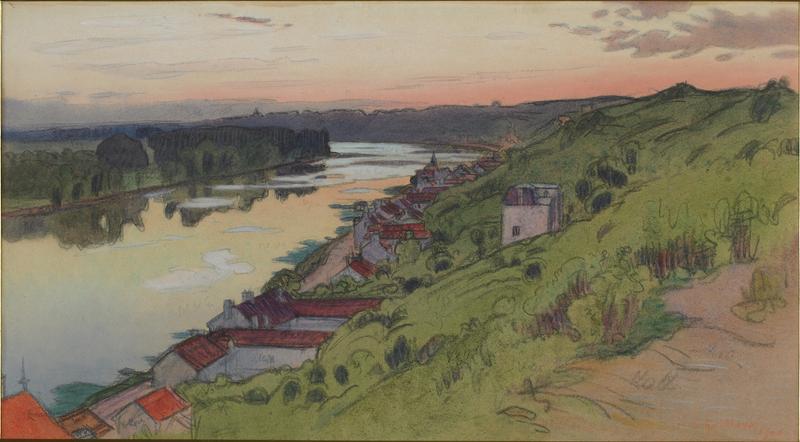
80. Charles Guilloux, Sunset at La Frette
| Artist | Charles Guilloux, French, Paris 1866–Lormes, Nièvre 1946 |
| Title, Date | Sunset at La Frette, 1900 |
| Medium | Watercolor and chalk highlighted with gouache |
| Dimensions | 9 1/2 × 17 3/8 in. (24.1 × 44.1 cm) |
| Inscriptions + Marks | Lower right in orange chalk: C. Guilloux / 1900 |
| Provenance | Possibly sold Hôtel Drouot, salle 10, June 6, 1907, no. 21, as “Coucher de la soleil à La Frette.” [Galerie Jacques Ancely, Paris, until 1994; to Weisberg]; Yvonne and Gabriel Weisberg, Minneapolis |
| Exhibition History | "The Quieter Image: 19th Century European Drawings and Watercolors," Carleton Art Gallery, Carleton College, Northfield, Minn., 1996, no. 27; "Expanding the Boundaries: Selected Drawings from the Yvonne and Gabriel P. Weisberg Collection," Mia (2008) and Snite Museum of Art, Notre Dame, Ind. (2010); "Reflections on Reality: Drawings and Paintings from the Weisberg Collection," Mia, 2022–23 |
| References | Lisa Dickinson Michaux with Gabriel P. Weisberg, "Expanding the Boundaries: Selected Drawings from the Yvonne and Gabriel P. Weisberg Collection" (exh. cat.), Minneapolis Institute of Arts (Minneapolis, 2008), pp. 77–78, fig. 47 |
| Credit Line | Promised gift of Gabriel P. and Yvonne M.L. Weisberg, Minneapolis |
Charles Guilloux worked at the Bibliothèque nationale, the mammoth national library in Paris. He was a self-taught artist and quite productive, participating successfully in numerous exhibitions and sales.1 In 1905, five years after he made this view along the Seine, he exhibited at the Salon of the Société Nationale des Beaux-Arts and eventually at the Salon des Indépendants, where he showed from 1911 until the outbreak of World War I, in 1914.
Guilloux favored oil, pastel, and watercolor, which he used primarily for landscapes, usually of rural and coastal views. He is best known for his symbolist paintings, but Sunset at La Frette seems more closely attuned to the post-impressionist style of his contemporary Henri Rivière (1864–1951), whose works were widely known through his printmaking activities. Rivière distilled elements of Japanese art into his work, and in this scene Guilloux may have picked up on his Japanese-inspired swaths of pure color, high vantage point, use of diagonals, and simplification of form. Rivière won a gold medal at the Exposition Universelle in 1900, the year Guilloux made this watercolor. Guilloux’s symbolist work took abstraction and flat fields of color to much greater extremes, however, putting him closer to the style of the Belgian painter Léon Spilliaert (1881–1946).
Though it has now been subsumed into the fabric of metropolitan Paris, in 1900 La Frette was a village on the north bank of the Seine. Guilloux’s view looks in a westerly direction. With the sky and water suffused with shades of pink, lavender, and blue, this scene has previously been interpreted as a sunrise, but the geography dictates that it is probably a sunset. Trees in full leaf reflected on the glassy water tell us how still this particular summer evening was. One can almost hear the buzzing of insects in the rolling grasses.
TER